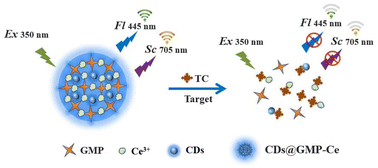A fluorescent and scattering dual-mode probe based on a carbon dot@cerium–guanosine monophosphate coordination polymer network for tetracycline detection†
Abstract
Dual-mode sensing with a two-signal read-out is conducive to the improvement of detection accuracy. Herein, a fluorescent and scattering dual-mode chemosensor for tetracycline (TC) is proposed based on a carbon dot@cerium–guanosine monophosphate (CD@GMP-Ce) coordination polymer network. The inexpensive CD@GMP-Ce was prepared by exploiting the adaptive inclusion capability of coordination polymers and possessed remarkable fluorescence and strong Rayleigh scattering. The functional CD@GMP-Ce demonstrated fluorescence and scattering, the two optical-signal responses to TC simultaneously. Based on TC-specific fluorescence and scattering decline, the dual-mode detection of TC was established and the probe's detection limits were 43 nM in the fluorescence mode and 77 nM in the scattering mode, respectively. Furthermore, the potential application of the dual-mode sensor was verified by measuring TC in milk and tap-water samples. The study not only provides a new perspective for the development of assay methods for TC but also expands the applications of cerium coordination polymers.

- This article is part of the themed collection: Analytical Methods HOT Articles 2022


 Please wait while we load your content...
Please wait while we load your content...